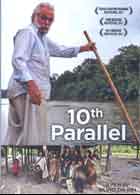
10th Parallel (Paralelo Dez) 2011
Distributed by Icarus Films, 32 Court St., 21st Floor, Brooklyn, NY 11201; 800-876-1710
Produced by Diálogo Comunicação
Directed by Silvio Da-Rin
DVD , color, 87 min.
College - General Adult
Anthropology, Latin American Studies, Indigenous Peoples
Date Entered: 12/05/2012
Reviewed by Brian Boling, Temple University LibrariesAfter a several year absence, José Carlos Meirelles returns to the lands where he once worked for FUNAI, the Brazilian government agency now tasked with preserving the lands and rights of indigenous peoples. When he began his work in 1970, the military dictatorship pursued a policy of contacting and integrating isolated tribes. In 1987, following democratic reform, Meirelles took part in a conference of anthropologists and indigenous rights activists who, recognizing the adverse effects brought by contact, petitioned FUNAI to reverse this policy. As such, he speaks authoritatively about the difficulties created by both of the attitudes towards isolated tribes taken by the Brazilian state.
The film uses a travelogue-like narrative structure, following Meirelles, anthropologist Txai Terri de Aquino, and colleagues on a down-river trip to invite members of the Ashaninka and Madijá tribes to a meeting to discuss their relations with “wild Indians.” In particular, the meeting that concludes the film addresses these groups’ concerns increasing incidents of theft by uncontacted tribes and the government’s parallel worry that retaliatory violence will ensue. Such scenes provide insight into how these two indigenous populations’ lives have been affected by contact. Viewers may find it striking that these partly assimilated peoples advocate for the “taming” of wild Indians. Viewers might also experience discomfort that both Meirelles and the meeting participants laugh at the otherness of isolated Indians during a slideshow of aerial photographs. These very contradictions will generate useful class discussions not only about Latin American policies towards indigenous populations, but about ethnographic practice in general.
While the film’s lack of voiceover narration allows viewers to draw their own conclusions, it also means that students or their instructors will need to make an extra effort to piece together some of the history described by the film. For example, Meirelles’ references to Brazil’s landless movement assume that the viewer understands the long term social context of this issue. In addition, the footage of the journey—itself absolutely breathtaking—may distract students from the primary issues considered by the film. For these reasons, the film is most appropriate for collections at universities with strong graduate programs in Latin American studies or anthropology.
On a technical note, the film follows the recent trend towards reduced font-size of subtitles, possibly rendering them illegible on monitors sized for dorm rooms or library viewing stations.